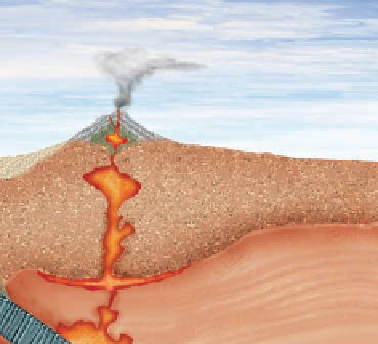Geology Reference
In-Depth Information
at convergent plate boundaries because temperature and
pressure increase as a result of plate collisions.
◗
Figure 7.20 illustrates the various metamorphic fa-
cies conditions present at a typical oceanic-continental
convergent plate boundary. When an oceanic plate col-
lides with a continental plate, tremendous pressure is gen-
erated as the oceanic plate is subducted. Because rock is
a poor heat conductor, the cold descending oceanic plate
heats slowly, and metamorphism is caused mostly by
increasing pressure with depth. Metamorphism in such
an environment produces rocks typical of the
blueschist
facies
(low temperature, high pressure). Geologists use the
presence of blueschist facies rocks as evidence of ancient
subduction zones.
As subduction along the oceanic-continental convergent
plate boundary continues, both temperature and pressure
increase with depth and yield high-grade metamorphic
rocks.
Eventually, the descending plate begins to melt and
generate magma that moves upward. This rising magma
may alter the surrounding rock by contact metamorphism,
producing migmatites in the deeper portions of the
crust and hornfels at shallower depths. High tempera-
tures and low to medium pressures characterize such an
environment.
Although metamorphism is most common along con-
vergent plate margins, many divergent plate boundaries are
characterized by contact metamorphism. At mid-oceanic
ridges, infiltration of seawater into hot crust and mantle
leads to patchy low- to intermediate-grade metamorphism
(Figure 7.4). In addition, fl uids emanating from the rising
magma—and its reaction with seawater—very commonly
produce metal-bearing hydrothermal solutions that may
◗
Figure 7.19
Metamorphic Facies and Their Associated
Temperature-Pressure Conditions A temperature-pressure diagram
showing under what conditions various metamorphic facies occur.
A metamorphic facies is characterized by a particular mineral
assemblage that formed under the same broad temperature-
pressure conditions. Each facies is named after its most
characteristic rock or mineral.
original rocks were pure quartz sandstone or pure limestone
or dolostone, metamorphism, regardless of the imposed
temperature and pressure conditions, will yield only quartz-
ite and marble, respectively. In such cases, all one can say is
that “metamorphism has happened.”
METAMORPHISM
Although metamorphism is associated with all three types
of plate boundaries (see Figure 1.13), it is most common
along convergent plate margins. Metamorphic rocks form
Volcanic
arc
CM
Forearc
basin
Accretionary
wedge
Back-arc
Depth
(km)
P
0
Z
Z
GS
GS
25
Z
EA
EA
P
A
A
50
GS
GR
BS
E
75
100
A
= amphibolite facies
BS
= blueschist facies
CM
= contact metamorphic zone
shown in green
E
= eclogite facies
EA
= epidote-amphibolite facies
GR
= granulite facies
GS
= greenschist facies
P
= prehnite-pumpellyite facies
Z
= zeolite facies
◗
Figure 7.20
Relationship of Facies to Major Tectonic Features at an Oceanic-Continental Convergent
Plate Boundary







Search WWH ::

Custom Search